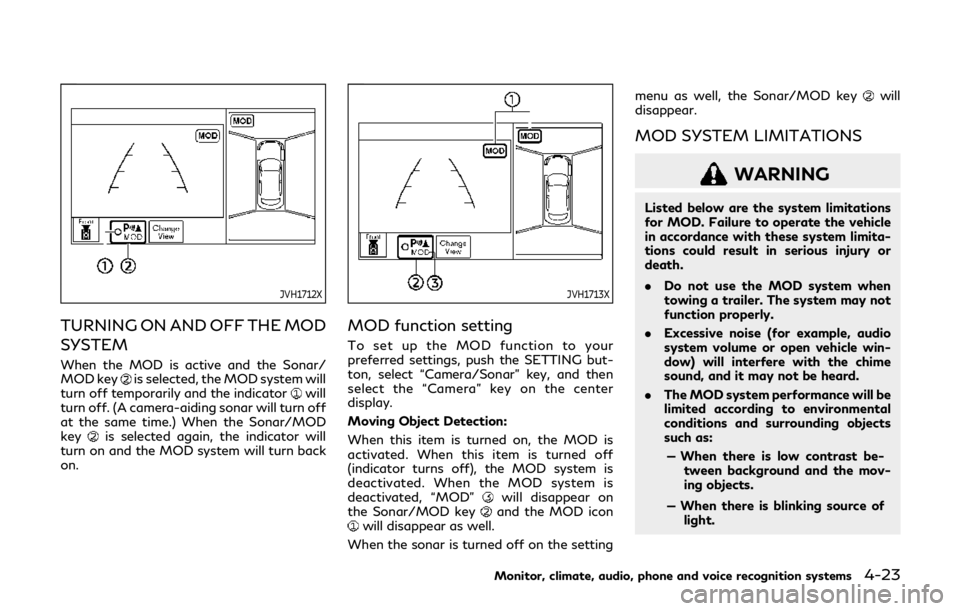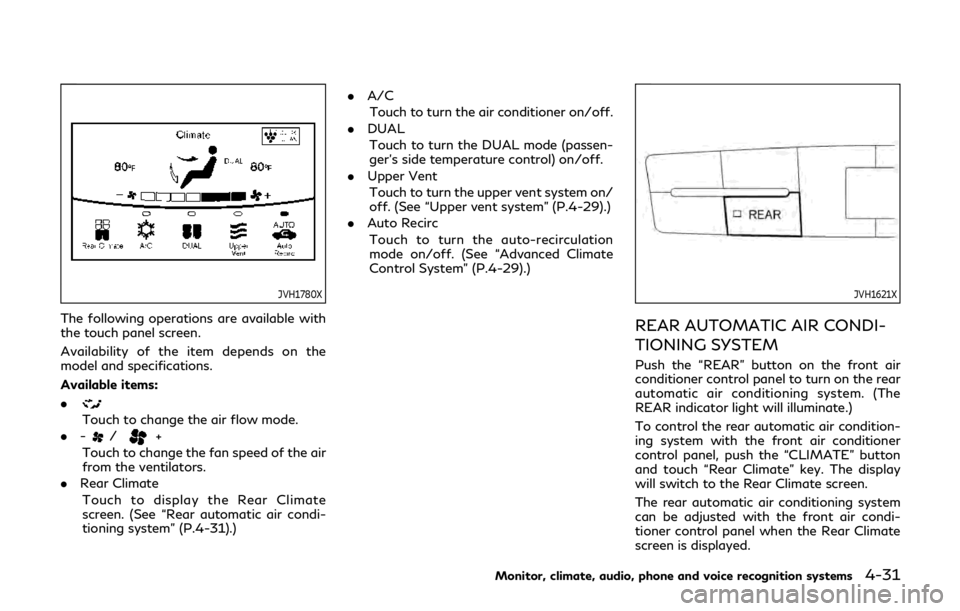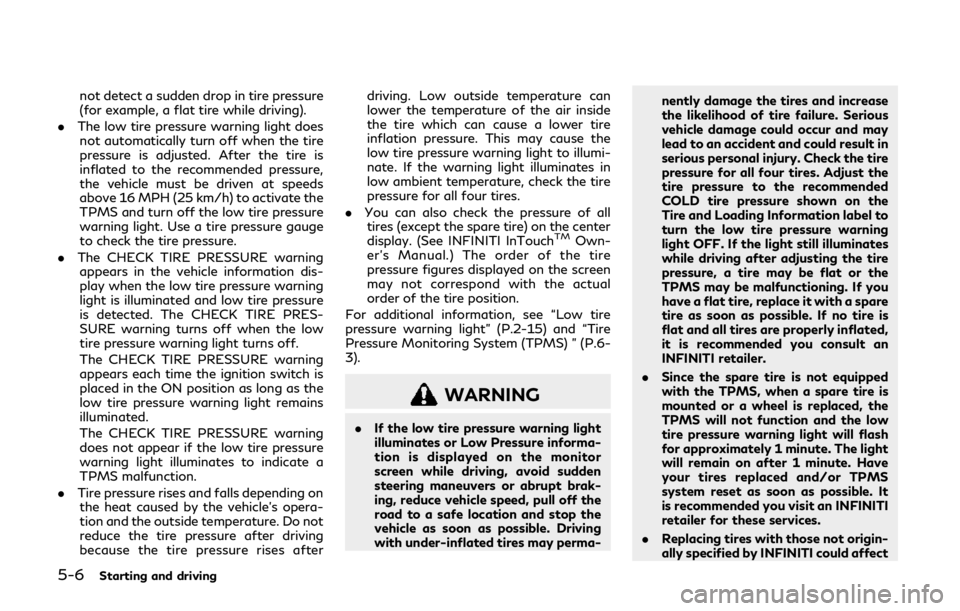display INFINITI QX80 2019 Repair Manual
[x] Cancel search | Manufacturer: INFINITI, Model Year: 2019, Model line: QX80, Model: INFINITI QX80 2019Pages: 524, PDF Size: 2.45 MB
Page 235 of 524

JVH1712X
TURNING ON AND OFF THE MOD
SYSTEM
When the MOD is active and the Sonar/
MOD keyis selected, the MOD system will
turn off temporarily and the indicatorwill
turn off. (A camera-aiding sonar will turn off
at the same time.) When the Sonar/MOD
key
is selected again, the indicator will
turn on and the MOD system will turn back
on.
JVH1713X
MOD function setting
To set up the MOD function to your
preferred settings, push the SETTING but-
ton, select “Camera/Sonar” key, and then
select the “Camera” key on the center
display.
Moving Object Detection:
When this item is turned on, the MOD is
activated. When this item is turned off
(indicator turns off), the MOD system is
deactivated. When the MOD system is
deactivated, “MOD”
will disappear on
the Sonar/MOD keyand the MOD iconwill disappear as well.
When the sonar is turned off on the setting menu as well, the Sonar/MOD key
will
disappear.
MOD SYSTEM LIMITATIONS
WARNING
Listed below are the system limitations
for MOD. Failure to operate the vehicle
in accordance with these system limita-
tions could result in serious injury or
death.
. Do not use the MOD system when
towing a trailer. The system may not
function properly.
. Excessive noise (for example, audio
system volume or open vehicle win-
dow) will interfere with the chime
sound, and it may not be heard.
. The MOD system performance will be
limited according to environmental
conditions and surrounding objects
such as:
— When there is low contrast be- tween background and the mov-
ing objects.
— When there is blinking source of light.
Monitor, climate, audio, phone and voice recognition systems4-23
Page 236 of 524

4-24Monitor, climate, audio, phone and voice recognition systems
— When strong light such as an-other vehicle’s headlight or sun-
light is present.
— When camera orientation is not in its usual position, such as when
mirror is folded.
— When there is dirt, water drops or snow on the camera lens.
— When the position of the moving objects in the display is not chan-
ged.
. The MOD system might detect flow-
ing water droplets on the camera
lens, white smoke from the muffler,
moving shadows, etc.
. The MOD system may not function
properly depending on the speed,
direction, distance or shape of the
moving objects.
. If your vehicle sustains damage to the
parts where the camera is installed,
leaving it misaligned or bent, the
sensing zone may be altered and the
MOD system may not detect objects
properly.
. When the temperature is extremely
high or low, the screen may not
display objects clearly. This is not a
malfunction.
JVH1213X
SYSTEM MAINTENANCE
CAUTION
.Do not use alcohol, benzine or thinner
to clean the camera. This will cause
discoloration. To clean the camera,
wipe with a cloth dampened with
diluted mild cleaning agent and then
wipe with a dry cloth.
. Do not damage the camera as the
monitor screen may be adversely
affected. If dirt, rain or snow accumulates on any of
the cameras
, the MOD system may not
operate properly. Clean the camera by
wiping with a cloth dampened with a diluted
mild cleaning agent and then wiping with a
dry cloth.
Page 240 of 524

4-28Monitor, climate, audio, phone and voice recognition systems
AUTOMATIC CLIMATE CON-
TROL
Automatic operation
Cooling and/or dehumidified heating
(AUTO):
This mode may be used all year round. The
system works automatically to control the
inside temperature, air flow distribution and
fan speed after the preferred temperature is
set manually.
1. Push the “AUTO” button on. (The in-dicator on the button will illuminate and
AUTO will be displayed.)
2. Turn the temperature control dial (driver side) to set the desired temperature.
The temperature of the passenger com-
partment will be maintained automati-
cally. Air flow distribution and fan speed
will also be controlled automatically.
3. You can individually set driver and front passenger side temperature using each
temperature control button. When the
“DUAL” button is pushed or the passen-
ger side temperature control button is
turned, the DUAL indicator will come on.
To turn off the passenger side tempera-
ture control, push the “DUAL” button.
4. To turn off the climate control system, push the “OFF” button. A visible mist may be seen coming from the
ventilators in hot, humid conditions as the air
is cooled rapidly. This does not indicate a
malfunction.
Dehumidified defrosting or defogging:
1. Push the “” front defroster button.
(The indicator light on the button will
illuminate.)
2. Turn the temperature control dial to set the desired temperature.
. To quickly remove ice from the outside of
the windows, push the fan speed in-
crease button “
” and set it to the
maximum position.
. As soon as possible after the windshield
is clean, push the “AUTO” button to
return to the auto mode.
. When the “
” front defroster button is
pushed, the air conditioner will automa-
tically be turned on at outside tempera-
tures above 23°F (−5°C) to defog the
windshield, and the air recirculate mode
will automatically be turned off.
Outside air is drawn into the passenger
compartment to improve the defogging
performance.
Manual operation
Fan speed control:
Push the fan speed increase “
”or
decrease “” buttons to manually control
the fan speed.
Push the “AUTO” button to return to auto-
matic control of the fan speed.
Temperature control:
Turn the temperature control dial to set the
desired temperature.
Air flow control:
Pushing the “MODE” manual air flow control
button selects the air outlet to:
: Air flows from center and side ventilators.
: Air flows from center and side ventilators and foot outlets.
: Air flows mainly from foot outlets.
: Air flows from defroster and foot outlets.
Air intake control (Without Advanced Cli-
mate Control System):
. Push the “
” air recirculation button to
recirculate interior air inside the vehicle.
The “
” indicator light on the button
will come on. The air recirculation mode
cannot be activated when the air condi-
tioner is in the front defrosting mode
“
”.
Page 242 of 524

4-30Monitor, climate, audio, phone and voice recognition systems
When the air flow is high, “” is displayed
on the screen and when the air flow is low,
the indication in the screen changes to “
”.
Plasmacluster®and Plasmacluster®ion are
registered trademarks of Sharp Corporation.
Exhaust gas/outside odor detection sensor:
This vehicle is equipped with an exhaust gas
detection sensor. When the automatic in-
take air control is ON, the sensor detects
industry odors such as pulp or chemicals, and
exhaust gas such as gasoline or diesel. When
such odors or gas are detected, the system
automatically changes from the outside air
circulation mode to the recirculation mode.
When the auto-recirculation button is
pushed under the following conditions, the
indicator light on the “
” button will
illuminate and the exhaust gas detection
sensor will turn on.
. The air flow control is not in the front
defroster mode (the indicator light on the
“
” front defroster button is turned
off).
. The outside temperature is about 32°F
(0°C) or more.
When the automatic intake air control is ON,
for the first 5 minutes, the recirculation
mode is selected to prevent dust, dirt and
pollen from entering the vehicle and cleans
the air inside of the vehicle with positive and
negative ions that are emitted from the ventilator.
After the 5 minutes, the sensor detects
exhaust gas and automatically alternates
between the recirculation mode and outside
air circulation mode.
JVH1630X
Operations on touch panel screen
Climate control settings can be operated on
the touch panel screen. Push the “CLIMATE”
button and turn the display to the Climate
screen.
For details of the touch panel operation on
the center display, see the separate INFINITI
InTouch
TMOwner’s Manual.
Page 243 of 524

JVH1780X
The following operations are available with
the touch panel screen.
Availability of the item depends on the
model and specifications.
Available items:
.
Touch to change the air flow mode.
. -
/+
Touch to change the fan speed of the air
from the ventilators.
. Rear Climate
Touch to display the Rear Climate
screen. (See “Rear automatic air condi-
tioning system” (P.4-31).) .
A/C
Touch to turn the air conditioner on/off.
. DUAL
Touch to turn the DUAL mode (passen-
ger’s side temperature control) on/off.
. Upper Vent
Touch to turn the upper vent system on/
off. (See “Upper vent system” (P.4-29).)
. Auto Recirc
Touch to turn the auto-recirculation
mode on/off. (See “Advanced Climate
Control System” (P.4-29).)
JVH1621X
REAR AUTOMATIC AIR CONDI-
TIONING SYSTEM
Push the “REAR” button on the front air
conditioner control panel to turn on the rear
automatic air conditioning system. (The
REAR indicator light will illuminate.)
To control the rear automatic air condition-
ing system with the front air conditioner
control panel, push the “CLIMATE” button
and touch “Rear Climate” key. The display
will switch to the Rear Climate screen.
The rear automatic air conditioning system
can be adjusted with the front air condi-
tioner control panel when the Rear Climate
screen is displayed.
Monitor, climate, audio, phone and voice recognition systems4-31
Page 244 of 524

4-32Monitor, climate, audio, phone and voice recognition systems
Push the “CLIMATE” button one more time,
the display will return to the Climate screen.
The rear automatic air conditioning system
can also be adjusted by using the rear air
conditioner control panel located on the rear
of the center console. (See “Rear air condi-
tioner control panel operation” (P.4-34).)
This table shows the relation between the
front air conditioner control panel and the
rear air conditioner control panel.
Display status
Rear Climate
screen is dis-
played Rear Climate
screen is not dis-
played (Climate
screen)
Front air
condition-
er control
panel Only the rear
automatic air
conditioning
system can be
operated Only the front air
conditioner can
be operated
Rear air
condition-
er control
panel Cannot be op-
erated Only the rear
automatic air
conditioning sys-
tem can be oper-
ated
Front air conditioner control panel
operation
Automatic operation:
1. Push the “REAR” button to turn on rear
automatic air conditioning system. Push the “CLIMATE” button and select the
“Rear Climate” key to display the Rear
Climate screen.
2. Push the “AUTO” button. (The AUTO indicator light will illuminate and “AUTO”
will appear on the display.)
3. Turn the temperature control dial (dri- ver’s side) to set the desired tempera-
ture.
Cooling and dehumidified heating:
1. Push the “REAR” button to turn on the rear automatic air conditioning system.
Push the “CLIMATE” button and touch
“Rear Climate” key to display the Rear
Climate screen.
2. Turn the temperature control dial (dri- ver’s side) to set the desired tempera-
ture.
3. Switch the air flow mode to
by
pushing the “MODE” button.
4. Push the “CLIMATE” button one more time to return to the Climate screen. If
the A/C indicator light does not illumi-
nate, push the “A/C” button. (The A/C
indicator light will turn on.)
NOTE:
When the front air conditioner is off, the
rear automatic air conditioning system only
operates the fan. When you would like to use the air conditioner, be sure to push the
“A/C” button on the front air conditioner
control panel to turn on the A/C indicator
light.
Manual operation:
.
Temperature control
Turn the temperature control dial (dri-
ver’s side) to set the desired tempera-
ture.
. Fan speed control
Push the fan speed control “
” button
or “” button to manually control the
fan speed.
. Air flow control
Push the “MODE” button to change the
air flow mode.
: The air outlet is fixed at foot level.
: The air outlet is fixed at both the head and foot levels.
: The air outlet is fixed at the head level.
Touch panel operation
The rear automatic air conditioning system
can also be controlled on the Rear Climate
screen.
Touch the “Rear Climate” key on the Climate
screen to display the Rear Climate screen.
Page 245 of 524

JVH1719X
Rear Climate screen
Available items:
. Temp Down
Touch to decrease the temperature.
. Temp Up
Touch to increase the temperature.
. ON/OFF
Touch to turn the rear automatic air
conditioning system on/off.
. Fan Down
The fan speed of the air from the
ventilators can be decreased.
. Fan Up
The fan speed of the air from the
ventilators can be increased. .
Auto
Touch to turn the auto mode on/off.
. Mode
Touch to select different air flow mode.
SAA3327
1. “OFF” button
2. Fan speed control button
3. “AUTO” button
4. Display
5. “MODE” button
6. “TEMP” button
Monitor, climate, audio, phone and voice recognition systems4-33
Page 246 of 524

4-34Monitor, climate, audio, phone and voice recognition systems
Rear air conditioner control panel
operation
Rear control buttons:
The rear seat passengers can adjust the rear
automatic air conditioning system using the
control switches on the rear of the center
console.
The rear control buttons do not function
when the Rear Climate screen is shown on
the front display. To activate the rear control
buttons, push the “CLIMATE” button and
switch the screen to the Climate screen.
.“OFF” button:
Rear automatic air conditioning system
off
. “
” button:
Rear fan speed control up/down
. “AUTO” button:
Rear automatic air conditioning system
on, AUTO mode on
. “MODE” button:
Rear air flow control change
. “TEMP” button:
Rear temperature control up/down
Turning the system off
Use the following methods to turn the rear
automatic air conditioning system off. .
Operating the front air conditioner con-
trol panel:
Push the “OFF” button on the front air
conditioner control panel when the Rear
Climate screen is displayed.
. Operating the Rear Climate screen:
Touch the “ON/OFF” key on the Rear
Climate screen when the rear automatic
air conditioning system is on.
. Operating the rear air conditioner control
panel:
Push the “OFF” button on the rear air
conditioner control panel when the Rear
Climate screen is not displayed.
SAA3088
SAA3058
Page 252 of 524

Turning the BSI system ON/OFF ........................ 5-45
How to enable/disable the BSI system .............. 5-46
BSI system limitations ............................................. 5-46
BSI driving situations ............................................... 5-47
System temporarily unavailable ............................ 5-53
System malfunction .................................................. 5-54
System maintenance ................................................ 5-54
Back-up Collision Intervention (BCI) (if
so equipped) ..................................................................... 5-55 BCI system operation .............................................. 5-57
How to enable/disable the BCI system ............. 5-61
BCI system precautions ........................................... 5-62
System temporarily unavailable ............................ 5-63
System malfunction .................................................. 5-64
System maintenance ................................................ 5-64
Cruise control (if so equipped) .................................... 5-65 Precautions on cruise control ................................ 5-65
Cruise control operations ....................................... 5-65
Intelligent Cruise Control (ICC) (if so equipped) ..... 5-66 How to select the cruise control mode ............... 5-68
Vehicle-to-vehicle distance control mode ......... 5-68
Conventional (fixed speed) cruise
control mode ............................................................. 5-84
Distance Control Assist (DCA) (if so equipped) ..... 5-87
DCA system operation ........................................... 5-89
Turning the DCA system ON/OFF ...................... 5-92
How to enable/disable the DCA system ........... 5-93
DCA system display and indicators ..................... 5-93
DCA system limitations ........................................... 5-94 System temporarily unavailable .......................... 5-97
System malfunction ................................................ 5-99
Sensor maintenance ............................................... 5-99
Forward Emergency Braking (FEB) with
pedestrian detection .................................................. 5-100 FEB with pedestrian detection
system operation .................................................. 5-102
Turning the FEB with pedestrian detection
system ON/OFF .................................................. 5-104
FEB with pedestrian detection
system limitations ................................................ 5-105
System temporarily unavailable ....................... 5-108
System malfunction ............................................. 5-109
System maintenance ........................................... 5-109
Predictive Forward Collision
Warning (PFCW) ......................................................... 5-110 PFCW system operation ..................................... 5-112
Turning the PFCW system ON/OFF .............. 5-113
PFCW system limitations ................................... 5-115
System temporarily unavailable ........................ 5-117
System malfunction .............................................. 5-117
System maintenance ............................................ 5-118
Break-in schedule ......................................................... 5-119
Fuel efficient driving tips ........................................... 5-119
Increasing fuel economy ........................................... 5-120
INFINITI all-mode 4WD
®(if so equipped) .......... 5-120
INFINITI all-mode 4WD®system .................... 5-121
4WD shift switch .................................................. 5-125
4WD shift indicator .............................................. 5-126
Page 256 of 524

5-6Starting and driving
not detect a sudden drop in tire pressure
(for example, a flat tire while driving).
. The low tire pressure warning light does
not automatically turn off when the tire
pressure is adjusted. After the tire is
inflated to the recommended pressure,
the vehicle must be driven at speeds
above 16 MPH (25 km/h) to activate the
TPMS and turn off the low tire pressure
warning light. Use a tire pressure gauge
to check the tire pressure.
. The CHECK TIRE PRESSURE warning
appears in the vehicle information dis-
play when the low tire pressure warning
light is illuminated and low tire pressure
is detected. The CHECK TIRE PRES-
SURE warning turns off when the low
tire pressure warning light turns off.
The CHECK TIRE PRESSURE warning
appears each time the ignition switch is
placed in the ON position as long as the
low tire pressure warning light remains
illuminated.
The CHECK TIRE PRESSURE warning
does not appear if the low tire pressure
warning light illuminates to indicate a
TPMS malfunction.
. Tire pressure rises and falls depending on
the heat caused by the vehicle’s opera-
tion and the outside temperature. Do not
reduce the tire pressure after driving
because the tire pressure rises after driving. Low outside temperature can
lower the temperature of the air inside
the tire which can cause a lower tire
inflation pressure. This may cause the
low tire pressure warning light to illumi-
nate. If the warning light illuminates in
low ambient temperature, check the tire
pressure for all four tires.
. You can also check the pressure of all
tires (except the spare tire) on the center
display. (See INFINITI InTouch
TMOwn-
er’s Manual.) The order of the tire
pressure figures displayed on the screen
may not correspond with the actual
order of the tire position.
For additional information, see “Low tire
pressure warning light” (P.2-15) and “Tire
Pressure Monitoring System (TPMS) ” (P.6-
3).
WARNING
. If the low tire pressure warning light
illuminates or Low Pressure informa-
tion is displayed on the monitor
screen while driving, avoid sudden
steering maneuvers or abrupt brak-
ing, reduce vehicle speed, pull off the
road to a safe location and stop the
vehicle as soon as possible. Driving
with under-inflated tires may perma- nently damage the tires and increase
the likelihood of tire failure. Serious
vehicle damage could occur and may
lead to an accident and could result in
serious personal injury. Check the tire
pressure for all four tires. Adjust the
tire pressure to the recommended
COLD tire pressure shown on the
Tire and Loading Information label to
turn the low tire pressure warning
light OFF. If the light still illuminates
while driving after adjusting the tire
pressure, a tire may be flat or the
TPMS may be malfunctioning. If you
have a flat tire, replace it with a spare
tire as soon as possible. If no tire is
flat and all tires are properly inflated,
it is recommended you consult an
INFINITI retailer.
. Since the spare tire is not equipped
with the TPMS, when a spare tire is
mounted or a wheel is replaced, the
TPMS will not function and the low
tire pressure warning light will flash
for approximately 1 minute. The light
will remain on after 1 minute. Have
your tires replaced and/or TPMS
system reset as soon as possible. It
is recommended you visit an INFINITI
retailer for these services.
. Replacing tires with those not origin-
ally specified by INFINITI could affect